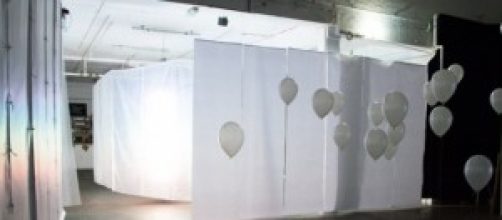Summer in London is a great celebration of art exhibitions, liveperformances and music. Among those, “Daze Exhibition” at Shapes Gallery:intense and fascinating, this installation has brought together works ofdifferent artists and designers interested in space, sense and interaction.
Here is our Q&A with the young and talented Joanna Penso, curator of theshow.
1. How did you get started into light installation art? How have you andyour work evolved and changed over the years?
I began using light last year when I became interested in how it canchange how you experience a space, however light has been important for me inmy work for a while beforehand.
I have become more focused on changing spacesso that the light source is the immediate center-point since startinguniversity. Changes in lighting and colour can affect our moodand behavior, and I'm interested in drawing attention to this fact; inmaking the viewer aware of their own methods of perception.
2. Let's focus on your last show, "Daze Exhibition". How would youdescribe this exhibition?
The starting point for DAZE exhibition was born out of a piece I made ina previous exhibition. I used sheets of tracing paper in front of the gallerywindows to control how much passers by would be able to see the work from thestreet. I wanted to expand on this idea by curating a show which would immerseyou in a maze of paper and other materials, which would lead you from one pieceto another.
It was important for me for the show to be cohesive and have a back-boneas an idea before I looked for artists to take part. I would describe it as ashow designed to immerse the viewer in the works as a whole experience, ratherthan isolated pieces to be contemplated on their own.
3. In Daze Exhibition you have showed your work alongside six other artists. Ipersonally found very interesting the idea of "blurring the lines ofauthorship" - how did this idea start?
From past experience of taking part in art exhibitions, I have foundthat unless you begin with an idea before you choose the work, the whole showis only loosely tied as one experience. By separating the space with sheets wecould control how the viewer experiences any one piece with lighting and spacearound the piece.
Blurring the lines of authorship was achieved by usingdifferent materials to create the walls of the maze, and lengthy discussions onhow this would affect the art piece in question, and the exhibit as a whole.The installation of the show was a huge task to take on itself, and although theinitial idea was my own, the group took it on and made it work for them. Wewere all involved with installing the whole show, and we decided not to use anyname tags on the work as the ideas were formed together, not inisolation.
4. What are your plans for the future?
At the moment I have one more year to complete my fine art degree atChelsea College of Art, but I am hoping to carry on with a heavy focus oncurating.
I have a strong interest in the cross-over between artist andcurator, in the sense that the artist can become the curator when workingtogether in a group to realise a concept as a whole, and the curator can becomethe artist when deciding which artists, venues and works to use.

